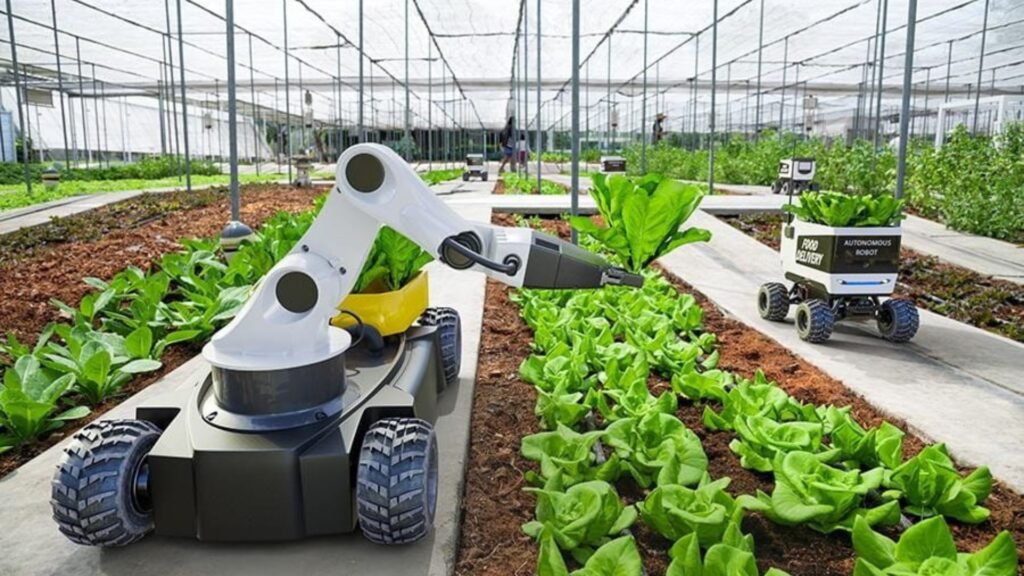The Role of Technology in Modern Agriculture
Technology is revolutionizing agriculture, transforming how farmers grow, manage, and harvest crops. Modern agricultural technology enhances efficiency, productivity, and sustainability. In this article, we’ll explore the role of technology in modern agriculture and how it’s shaping the future of farming.

Precision Agriculture
Precision agriculture uses technology to optimize crop production and reduce waste. By utilizing various tools and techniques, farmers can manage their fields with greater accuracy.
- Key Technologies in Precision Agriculture:
- GPS: Global Positioning System (GPS) technology helps farmers map their fields and apply inputs like water, fertilizer, and pesticides more precisely.
- Drones: Drones provide aerial imagery and data to monitor crop health, assess field conditions, and detect issues like pest infestations.
- Sensors: Soil and weather sensors collect real-time data on soil moisture, temperature, and nutrient levels, allowing farmers to make informed decisions.
Automated Machinery
Automated machinery has significantly improved efficiency and productivity in farming. Modern equipment is designed to handle various tasks with minimal human intervention.
- Examples of Automated Machinery:
- Tractors: Modern tractors come with advanced features like automatic steering and variable rate technology to optimize planting and harvesting.
- Harvesters: Automated harvesters can efficiently gather crops, reducing labor costs and minimizing crop loss.
- Planters: High-tech planters ensure accurate seed placement and optimal spacing, improving crop yields.
Data Analytics and Farm Management Software
Data analytics and farm management software are transforming how farmers manage their operations. These tools help with decision-making and optimize farm performance.
- Benefits of Farm Management Software:
- Data Analysis: Software analyzes data from various sources, including sensors and weather forecasts, to provide insights into crop performance and field conditions.
- Resource Management: Helps manage resources like water, fertilizers, and labor more efficiently.
- Predictive Analytics: Uses historical data and trends to predict future conditions and optimize planting and harvesting schedules.
Genetic Engineering and Biotechnology
Genetic engineering and biotechnology are advancing crop and livestock production by enhancing traits like resistance to pests and diseases.
- Applications of Biotechnology:
- Genetically Modified Crops: Crops can be engineered to withstand harsh conditions, resist pests, and improve nutritional content.
- CRISPR Technology: CRISPR allows precise editing of plant and animal genes to enhance desirable traits.
- Biopesticides: Biopesticides derived from natural sources help control pests without harmful chemicals.
Sustainable Farming Practices
Technology plays a crucial role in promoting sustainable farming practices that reduce environmental impact and conserve resources.
- Sustainable Innovations:
- Water Management Systems: Advanced irrigation systems, such as drip irrigation, minimize water waste and ensure efficient use.
- Cover Crops: Technology helps select and manage cover crops that improve soil health and prevent erosion.
- Organic Farming Tools: Tools and techniques for organic farming support soil fertility and pest management without synthetic chemicals.
Robotics and Automation
Robotics and automation are becoming increasingly common in agriculture, performing tasks that were previously labor-intensive.
- Robotic Applications:
- Weeding Robots: Robots equipped with cameras and sensors can identify and remove weeds with precision.
- Milking Robots: Automated milking systems improve dairy farming efficiency by handling the milking process.
- Planting Robots: Robots can plant seeds, monitor crop growth, and even perform thinning tasks.
The Internet of Things (IoT) in Agriculture
The Internet of Things (IoT) connects devices and systems to collect and exchange data, enhancing farm management and operations.
- IoT Applications:
- Smart Sensors: IoT-enabled sensors monitor environmental conditions, soil health, and crop growth, providing real-time data to farmers.
- Connected Equipment: Farm equipment and machinery can communicate with each other and with farm management systems for coordinated operations.
- Remote Monitoring: IoT devices allow farmers to monitor their operations remotely, improving oversight and decision-making.
Challenges and Future Prospects
While technology offers many benefits, it also presents challenges that must be addressed.
- Challenges:
- Cost: Implementing advanced technologies can be expensive, particularly for small-scale farmers.
- Training: Farmers need training to effectively use and manage new technologies.
- Data Security: Protecting sensitive data and ensuring cybersecurity are important considerations as technology becomes more integrated into farming.
The future of agriculture will continue to be shaped by technological advancements, offering new opportunities for efficiency, productivity, and sustainability. As technology evolves, it will further transform how we grow and manage food, supporting a more secure and sustainable global food system.
Conclusion
Technology is playing a transformative role in modern agriculture, enhancing precision, automation, data management, and sustainability. From precision agriculture and automated machinery to genetic engineering and IoT, technological innovations are reshaping the way farmers operate and produce food. While challenges remain, the ongoing advancements promise a brighter future for agriculture, with increased efficiency and sustainability at the forefront.



